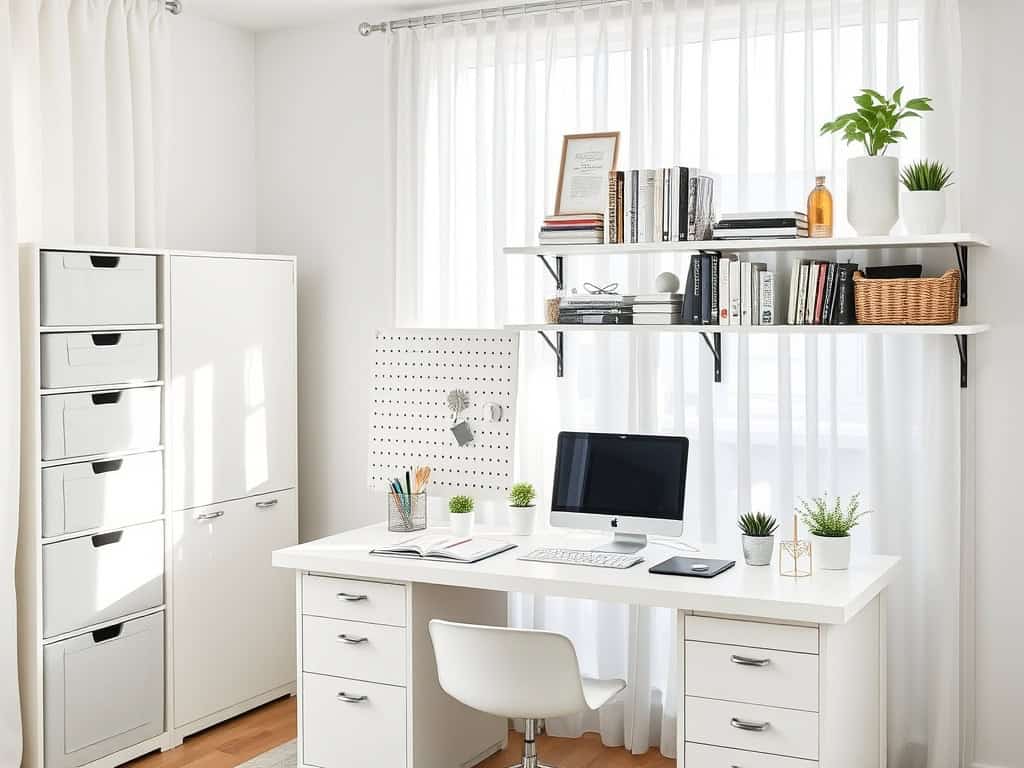If you’re struggling to keep your home office organized, you’re not alone! As someone who’s tested countless storage solutions, I can tell you that IKEA offers some of the most practical and budget-friendly options around. From the versatile KALLAX shelving that transformed my own workspace to clever vertical storage hacks, these ten IKEA solutions will help you create an efficient, clutter-free environment where you can actually focus on getting things done.
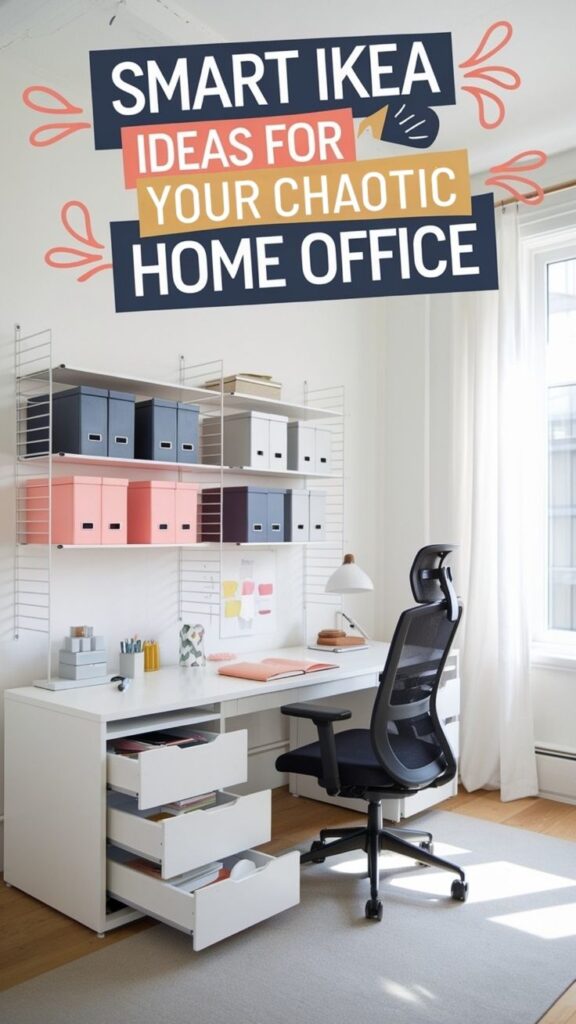
KALLAX Shelving Unit: The Perfect Balance of Open and Closed Storage
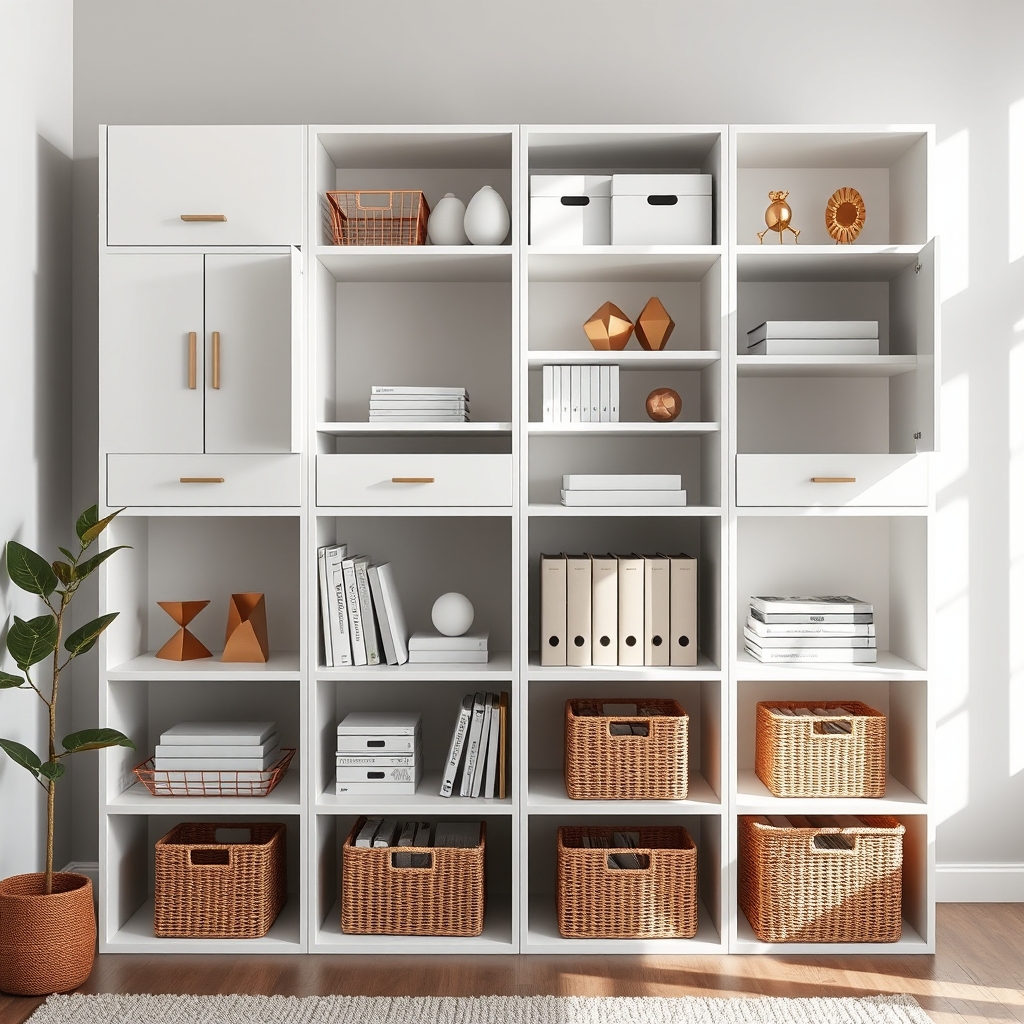
A well-organized KALLAX shelving unit serves as the cornerstone of an efficient home office storage system. The versatile cube design allows for a strategic mix of open shelving and closed storage solutions, making it possible to display decorative items while concealing office supplies and paperwork that could create visual clutter.
The key to maximizing the KALLAX’s potential lies in thoughtful planning and implementation of various storage inserts and accessories. By creating designated zones within the unit, you can maintain a professional appearance while ensuring every item has its proper place, ultimately leading to improved productivity and workspace functionality.
Required Items:
- KALLAX shelf inserts with doors
- KALLAX shelf inserts with drawers
- Storage boxes
- Label maker
- Drawer organizers
- Bookends
- File folders
- Decorative baskets
- Cable ties
- Measuring tape
Start by assessing your storage needs and mapping out the KALLAX grid on paper, designating specific cubes for different purposes. Install drawer inserts in the bottom cubes for heavy items and frequently accessed supplies. Place door inserts at eye level or above for items that should be concealed but easily accessible.
Reserve open cubes for decorative items, books, or display-worthy office accessories. Group similar items together using the zone method: create distinct areas for active projects, reference materials, supplies, and personal items. Utilize storage boxes and baskets in open cubes to maintain a cohesive look while providing additional organization.
For paperwork, implement a color-coding system using file folders that can be stored either vertically or horizontally depending on your needs.
Maintenance Tip: Review the contents of your KALLAX unit quarterly, removing unnecessary items and adjusting the organization system as your needs change. Consider rotating decorative elements seasonally to keep the space feeling fresh, and always maintain clear labels on closed storage components for quick identification of contents.
ALEX Drawer Unit on Wheels: Mobile Organization Made Easy
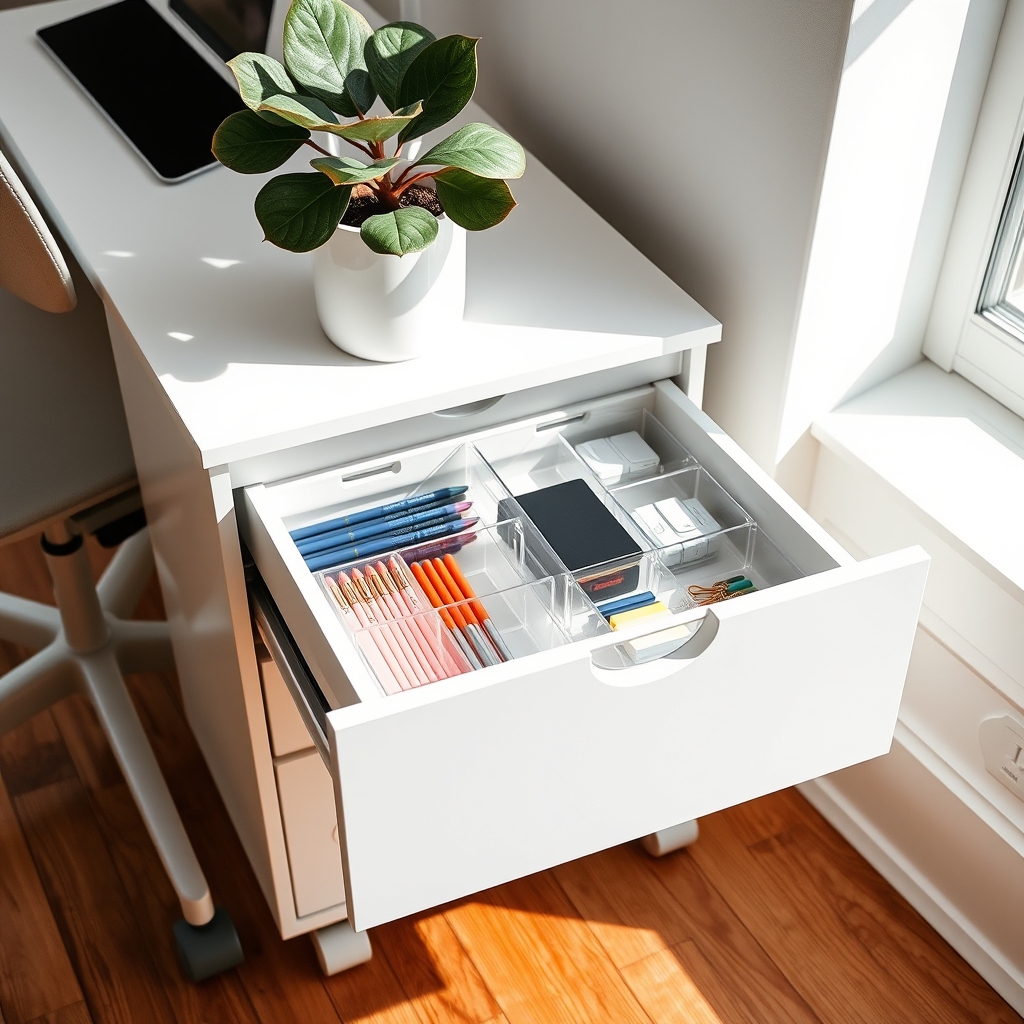
A well-organized mobile drawer unit serves as the backbone of an efficient home office setup, providing essential storage while maintaining flexibility in your workspace. The ALEX drawer unit’s portable nature allows you to adapt your office layout while keeping necessary supplies within arm’s reach, eliminating the frustration of searching for items when you need them most.
The key to maximizing the ALEX drawer unit’s potential lies in creating designated zones for different categories of supplies while maintaining a system that works with your daily workflow. Its combination of shallow and deep drawers makes it perfect for storing everything from small stationery items to larger office supplies and documents.
Required Items:
- Drawer dividers
- Small containers or organizer boxes
- Label maker or labels
- Measuring tape
- Clear plastic bins
- File folders
- Document sorters
- Cable management clips
- Drawer liner material
Start by emptying all drawers and measuring their internal dimensions. Assign specific purposes to each drawer based on frequency of use – place daily items in top drawers and less-used items toward the bottom. Use drawer dividers to create sections within each drawer, ensuring items stay organized when the unit is moved. Install drawer liners to prevent items from sliding around during movement.
For the shallow drawers, implement a system of small containers to separate writing tools, sticky notes, paper clips, and other frequently used items. The deeper drawers can accommodate file folders for documents, larger supplies, or technology accessories. Use clear containers to maintain visibility of contents and label everything clearly.
Consider using cable management clips along the sides of the unit to keep charging cables organized and easily accessible when needed. Place frequently used items in the top drawers for quick access, while storing backup supplies and archived materials in lower drawers.
Regular maintenance of your organization system is crucial – schedule monthly quick cleanouts to prevent clutter accumulation and maintain the efficiency of your mobile storage solution.
SKÅDIS Pegboard System: Vertical Storage That Works

IKEA Home Office Storage Solutions
SKÅDIS Pegboard System: Vertical Storage That Works
Vertical storage solutions have become increasingly vital in modern home offices where square footage is often limited. The SKÅDIS pegboard system transforms unused wall space into a highly functional organizational hub, allowing easy access to frequently used items while keeping the workspace clear and uncluttered.
By implementing a well-planned SKÅDIS system, you can create designated zones for different categories of office supplies, tools, and accessories. This vertical organization method not only maximizes space efficiency but also promotes better workflow and reduces time spent searching for essential items.
Required Items:
- SKÅDIS Pegboard
- Wall mounting hardware
- SKÅDIS hooks (various sizes)
- SKÅDIS containers
- SKÅDIS clips
- SKÅDIS shelves
- SKÅDIS letter holder
- Level
- Pencil
- Drill
- Measuring tape
Mount the SKÅDIS pegboard at a comfortable height, ensuring it’s level and properly secured to wall studs. Begin organizing by grouping similar items together and determining their frequency of use.
Position frequently accessed items at eye level and arm’s reach, while storing less-used items higher or lower. Arrange containers and hooks to accommodate different item sizes, keeping heavier items toward the bottom for stability.
Create designated zones on your pegboard: a supplies section for writing tools and scissors, a tech zone for cables and chargers, and a documentation area for important papers and notes.
Test the arrangement by performing common tasks and adjust the layout as needed for optimal workflow. Consider implementing a color-coding system or labels to maintain organization long-term.
Leave some empty space for future additions and rotate items seasonally based on usage patterns. Regular maintenance of the system, including weekly straightening and monthly evaluation of item placement, will ensure the SKÅDIS continues to serve its organizational purpose effectively.
KVISSLE Wall Magazine Rack: Declutter Your Desktop

A cluttered desktop can significantly impact productivity and mental clarity in your home office. Papers, magazines, and documents scattered across your workspace create visual noise and make it difficult to locate important materials when needed. The KVISSLE wall magazine rack offers an elegant vertical storage solution that transforms chaotic paper piles into an organized, accessible system.
By utilizing wall space effectively, the KVISSLE rack helps maintain a clear desk while keeping frequently referenced materials within arm’s reach. Its sleek white design and multiple compartments allow for systematic organization of different document categories, making it an essential tool for maintaining an efficient home office environment.
Required Items:
- KVISSLE Wall Magazine Rack
- Mounting hardware (screws and wall anchors)
- Power drill
- Level
- Pencil
- Measuring tape
- Document categories/labels
- Files and papers to organize
Begin by sorting all desktop papers into clear categories such as “Action Items,” “Reference Materials,” “Bills,” and “Archive Documents.”
Install the KVISSLE rack at eye level on your office wall, ensuring proper mounting with wall anchors for stability. Position it within easy reach of your primary workspace, typically 24-30 inches from your desk surface. Use the level to guarantee straight installation.
Once mounted, assign specific compartments to your predetermined categories, working from top to bottom in order of priority or frequency of use. Place time-sensitive documents in the upper slots for increased visibility and easier access. Arrange materials with spines or labels facing outward for quick identification.
Additional Tips: Establish a weekly maintenance routine to prevent new paper buildup. Regularly review and purge outdated materials, and consider implementing a one-in-one-out policy to maintain manageable document volumes.
For optimal organization, combine the KVISSLE rack with a simple color-coding system or labeled folders to further streamline document retrieval and filing processes.
BEKANT Storage Unit on Casters: Professional-Grade Filing
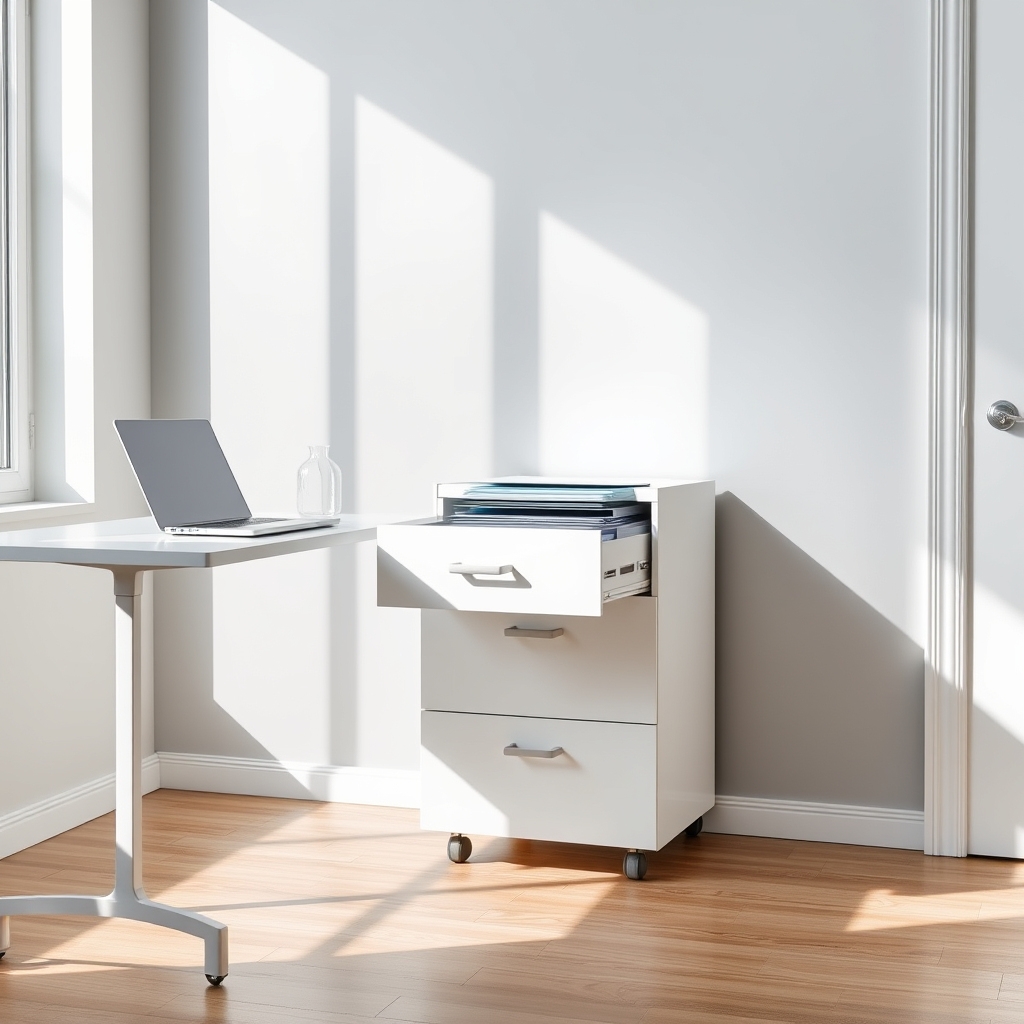
Professional filing systems form the backbone of an efficient home office, and the BEKANT Storage Unit on Casters offers a versatile solution for managing documents and supplies. Its mobile design allows for flexible workspace arrangements while maintaining easy access to important files and materials.
The unit’s professional-grade construction, combined with smart organizational strategies, can transform cluttered paperwork into an intuitive filing system. When properly organized, this storage solution can significantly reduce time spent searching for documents and improve overall workflow efficiency.
Required Items:
- BEKANT Storage Unit on Casters
- Hanging file folders
- File folder labels
- Label maker or marker
- Document sorting trays
- File folder tabs
- Paper clips and binder clips
- Archive boxes
- Document shredder
Begin by completely emptying the BEKANT unit and sorting all documents into three categories: active files, reference materials, and archives. Install hanging file folders in the top drawer, using a clear labeling system that aligns with your workflow.
Dedicate the middle drawer to frequently accessed supplies and current projects, utilizing the unit’s adjustable shelving to maximize vertical space. The bottom drawer works well for archive files or less frequently accessed materials, organized chronologically or by project phase.
The unit’s smooth-rolling casters allow for creating designated zones within your workspace. Position active projects within arm’s reach of your desk, while moving reference materials to a secondary area.
Take advantage of the unit’s locking mechanism to secure sensitive documents when needed. For optimal organization, implement a regular maintenance schedule, reviewing files monthly to prevent clutter accumulation.
Use color-coding for different categories of files, and maintain a master index of contents on your computer. Consider scanning important documents for digital backup while maintaining physical copies in the BEKANT unit for easy access.
TJENA Box With Lid: Stylish Paper and Supply Organization
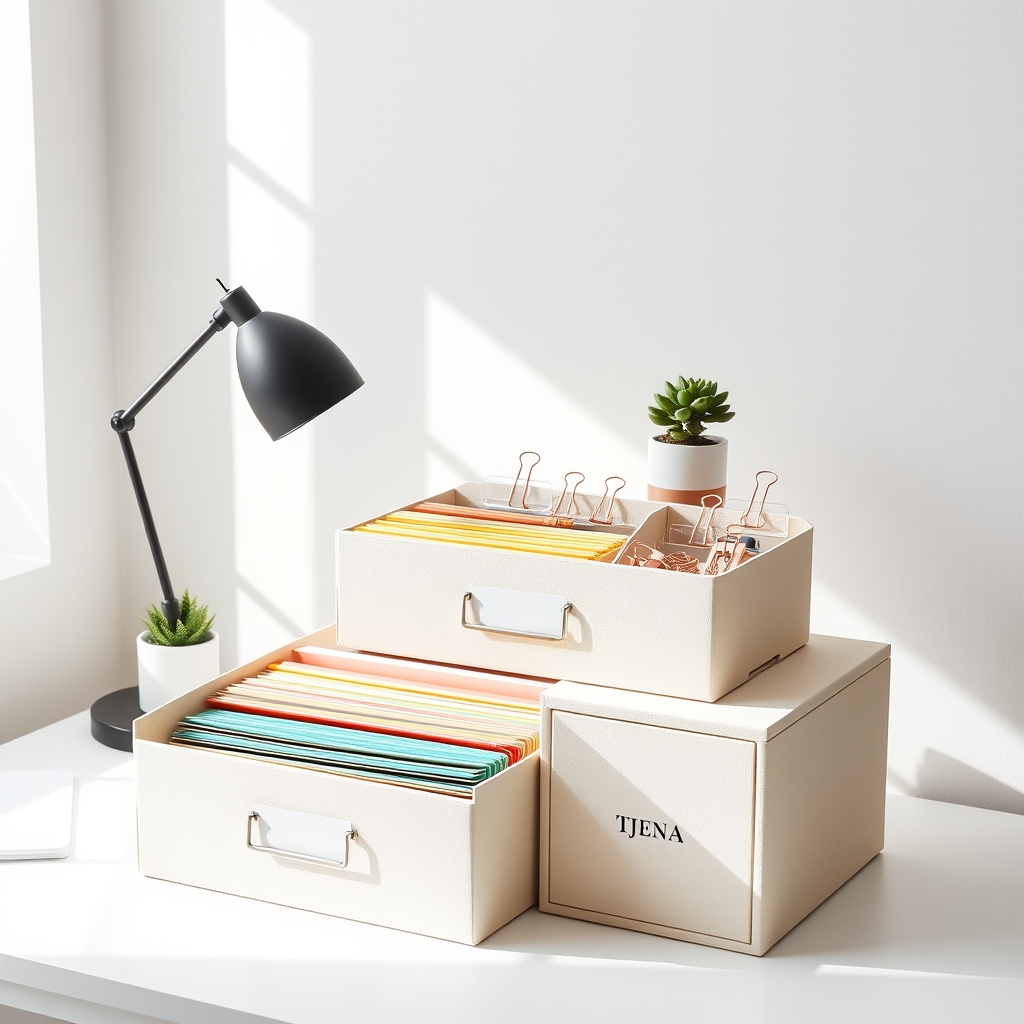
A well-organized home office starts with proper paper and supply management. The TJENA box system from IKEA offers an elegant solution to the constant challenge of keeping documents, writing implements, and office supplies in order while maintaining a clean, minimalist aesthetic.
The stackable design and neutral color options of TJENA boxes make them perfect for creating a cohesive storage system that works in any space. These boxes not only hide visual clutter but also protect important documents and supplies from dust while keeping them easily accessible.
Required Items:
- TJENA boxes with lids (various sizes)
- Label maker or adhesive labels
- Drawer dividers or small containers
- Document sorting folders
- Paper clips and binder clips
- File folders
- Measuring tape
- Pen/pencil holders
Start by assessing your supplies and sorting them into categories: daily-use items, archive materials, and occasional-use supplies. Select appropriately sized TJENA boxes for each category, ensuring they fit your workspace dimensions.
Place frequently accessed items in medium-sized boxes at desk level, while storing archival materials in larger boxes that can be placed on higher shelves.
For optimal organization, create designated zones within each box using smaller containers or dividers. Label both the box exterior and interior compartments clearly.
Store writing implements vertically in dedicated holders, and use paper organizers to separate different types of documents. Stack boxes strategically, keeping daily essentials within arm’s reach.
To maintain the system, implement a regular review schedule every three months. Remove outdated materials, restock supplies as needed, and adjust the organization system based on changing needs.
Consider keeping a small inventory list inside each box lid to track contents and maintain order over time.
LACK Wall Shelf Unit: Floating Storage for Small Spaces
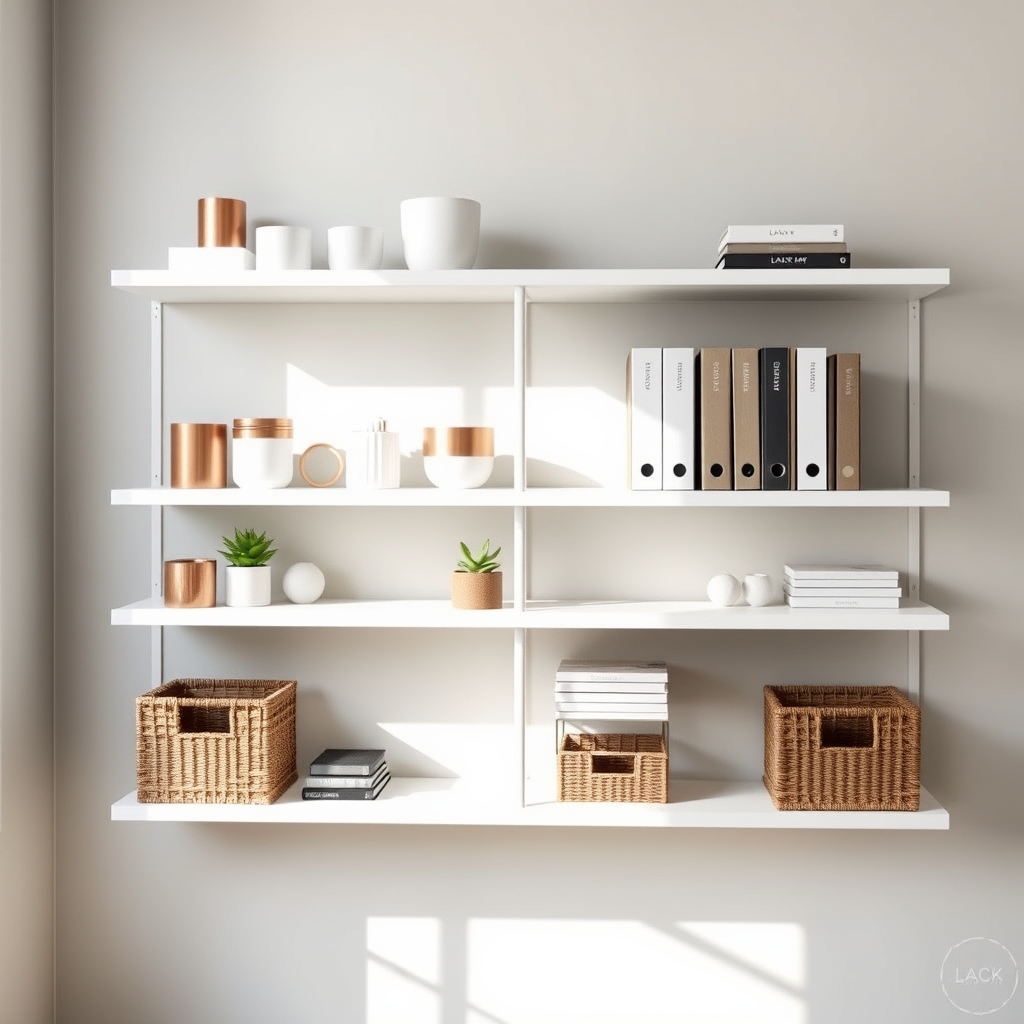
The LACK wall shelf unit stands as an elegant solution for maximizing vertical storage in compact home offices. These floating shelves provide a clean, minimalist approach to organization while keeping essential items within arm’s reach without consuming valuable floor space.
Proper organization of LACK wall shelves transforms them from simple wall fixtures into functional storage zones that contribute to a clutter-free workspace. Strategic arrangement of office supplies, decorative elements, and frequently used items can create an efficient system that enhances both productivity and aesthetic appeal.
Required Items:
- LACK wall shelf unit
- Level
- Pencil
- Measuring tape
- Wall anchors
- Screwdriver
- Storage containers or baskets
- Bookends
- Cable clips or ties
- Label maker
- Cleaning cloth
The organization process begins with a thorough assessment of items to be stored, grouping similar objects together. Heavy items should be positioned closer to shelf brackets for optimal weight distribution.
Create designated zones on each shelf: the top shelf for decorative items and rarely-used supplies, middle shelves for frequently accessed materials, and lower shelves for heavier items and reference materials.
For maximum efficiency, incorporate small containers or baskets to corral loose items like paper clips, thumb tacks, and sticky notes. Position books and magazines vertically using bookends, leaving approximately 20% of shelf space empty for future additions.
Thread cables through provided openings or secure them along shelf edges using adhesive clips to maintain a tidy appearance.
Additional Tips:
Rotate items seasonally to ensure frequently used supplies remain easily accessible. Implement a quarterly cleaning and reorganization schedule to prevent clutter accumulation.
Consider using clear containers to quickly identify contents, and maintain a consistent color scheme in storage solutions to preserve the minimalist aesthetic of the LACK design.
HELMER Drawer Unit: Compact Storage for Essentials
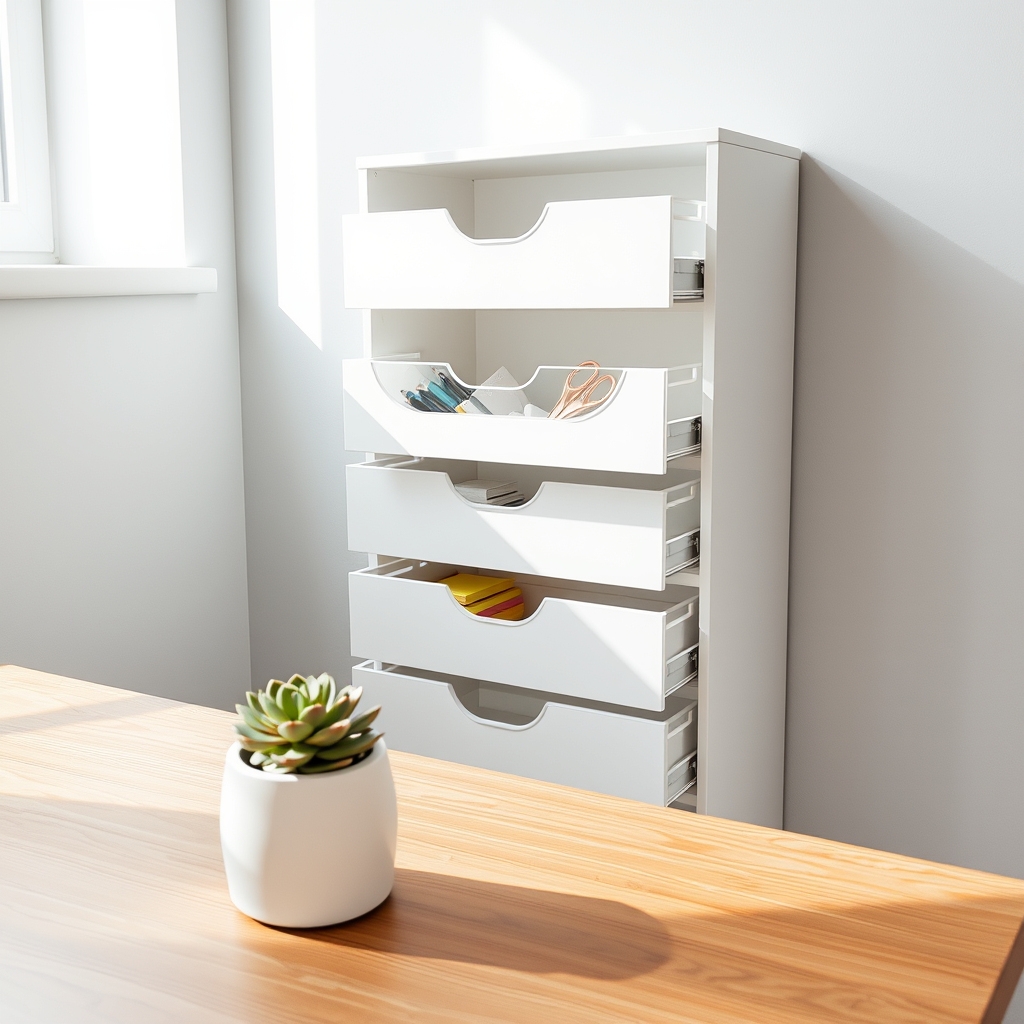
A well-organized drawer unit is essential for maintaining an efficient and productive home office environment. The HELMER drawer unit, with its six compact drawers, provides an ideal solution for storing and organizing office supplies, documents, and personal items while maximizing limited space.
The key to optimizing the HELMER unit lies in creating designated spaces for different categories of items, making them easily accessible when needed. This systematic approach not only saves time but also helps maintain long-term organization, reducing clutter and stress in your workspace.
Required Items:
- Drawer dividers
- Small containers or organizer boxes
- Label maker or labels
- Measuring tape
- Clear plastic bags
- Drawer liner (non-slip)
- File folders
- Paper clips and rubber bands
The organization process begins with emptying all drawers and cleaning them thoroughly. Line each drawer with non-slip material to prevent items from sliding.
Designate specific drawers for different categories: top drawer for frequently used items like pens, staplers, and scissors; second drawer for paper supplies and notebooks; third drawer for technology accessories; fourth drawer for filing important documents; fifth drawer for craft supplies; and bottom drawer for rarely used items or backup supplies.
Utilize drawer dividers and small containers to create compartments within each drawer, ensuring items remain separated and easily identifiable. Measure the interior dimensions of the drawers and plan the layout before placing organizers.
Group similar items together and position them based on frequency of use, with most-used items at the front of drawers.
For optimal maintenance, implement a quarterly review system to assess the organization system’s effectiveness and make necessary adjustments. Remove items that haven’t been used in six months, replace worn organizers, and regularly clean drawer interiors.
Consider using clear containers to quickly identify contents and maintain drawer dividers properly aligned to prevent items from mixing between sections.
KUGGIS Box With Lid: Multi-Purpose Storage Solutions
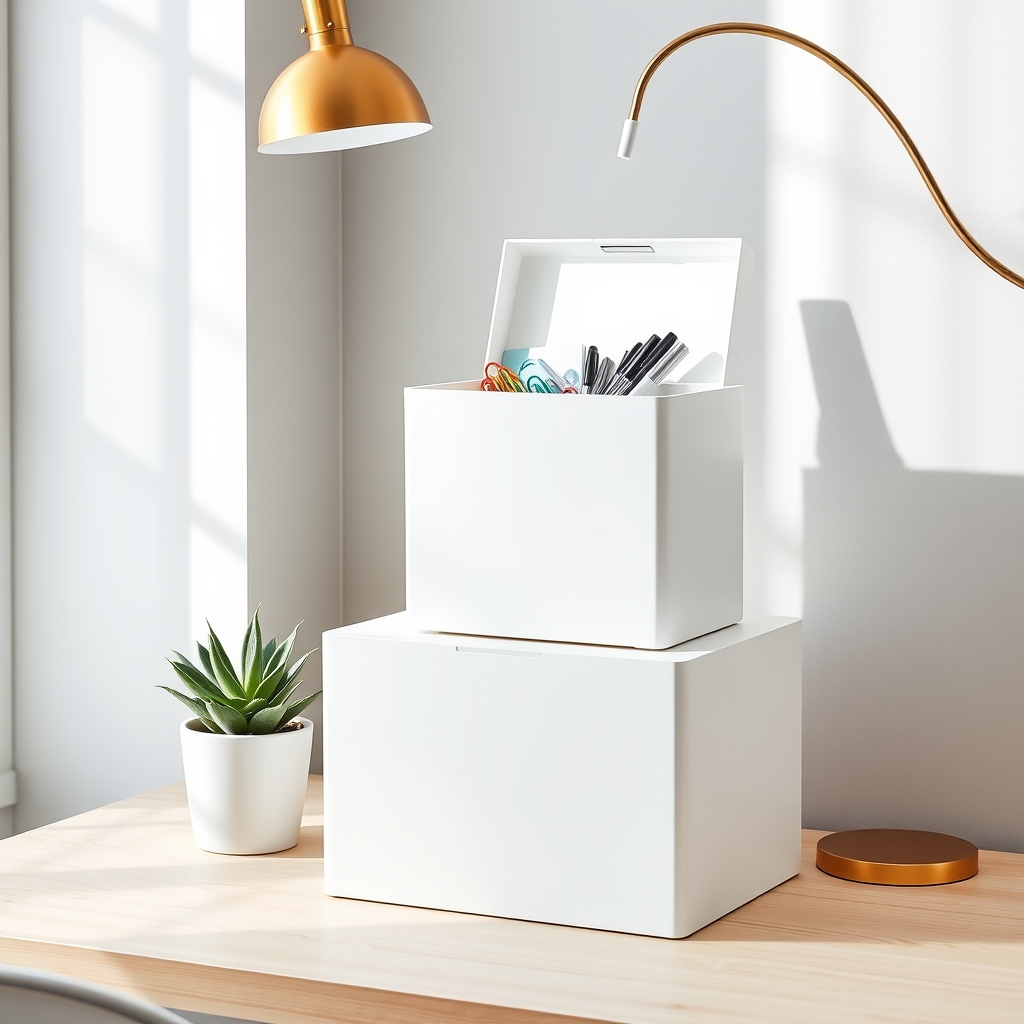
A well-organized home office requires efficient storage solutions that combine functionality with aesthetic appeal. The IKEA KUGGIS Box with lid stands out as a versatile storage option that helps maintain order while keeping items dust-free and easily accessible.
These stackable boxes seamlessly blend into any office environment, making them ideal for both visible storage and hidden organization within cabinets or shelves. The KUGGIS system’s modular design allows for customizable storage solutions that can evolve with changing needs.
Whether storing office supplies, documents, electronics, or personal items, these boxes provide a clean, minimalist approach to organization while maintaining professional appearance and practical functionality.
Required Items:
- KUGGIS Box with lid (various sizes)
- Labels or label maker
- Drawer liner or anti-slip mat
- Dividers (optional)
- Small containers for compartmentalizing
- Measuring tape
- List of items to be stored
The organization process begins with assessing your storage needs and selecting appropriate KUGGIS box sizes. Sort items into categories based on frequency of use and function.
Place frequently accessed items in easily reachable boxes, using smaller sizes for desktop placement and larger ones for cabinet or shelf storage. Install anti-slip mats in the bottom of each box to prevent items from sliding around, particularly in larger sizes.
For maximum efficiency, create designated zones within larger KUGGIS boxes using smaller containers or dividers. Label each box clearly, either on the lid or front face, ensuring visibility whether boxes are stacked or stored individually.
Consider color-coding labels by category for quick identification.
Additional Tips: Regularly review and adjust your organization system every few months to maintain its effectiveness. Consider using clear KUGGIS boxes for items that need visual identification, and stack boxes no more than three high for stable access.
Keep an inventory list of box contents, particularly for less frequently used items, to avoid unnecessary searching. Remember to leave some empty space in each box to accommodate future additions and maintain easy access to stored items.
ERIK File Cabinet: Traditional Filing With Modern Appeal

A well-organized file cabinet serves as the backbone of any efficient home office, combining practical storage with easy accessibility. The IKEA ERIK file cabinet offers a sleek, modern solution to traditional filing needs while maintaining professional functionality.
The key to maximizing the ERIK cabinet’s potential lies in creating a systematic approach to filing that aligns with your workflow. When properly organized, this cabinet can transform cluttered paperwork into an intuitive system that saves time and reduces stress during document retrieval.
Required Items:
- Hanging file folders
- File folder labels
- Label maker or marker
- File folder tabs
- Document sorter
- Recycling bin
- Paper clips and binders
- Archive boxes (for overflow)
- Measurement tape
- File folder dividers
Begin by completely emptying the file cabinet and measuring the interior dimensions to ensure proper fitting of hanging folders. Sort documents into major categories such as “Financial,” “Personal,” “Work,” and “Home.” Create subcategories within each main category and label hanging folders accordingly.
Position the hanging folders in the cabinet, ensuring they slide smoothly on the rails. Arrange folders alphabetically or by frequency of use, with the most accessed files at the front of each drawer. For deep drawers, consider using box-bottom hanging folders to prevent papers from folding at the bottom.
Additional organization success depends on regular maintenance and practical habits. Schedule quarterly reviews to purge outdated documents, archive less-frequently needed items, and adjust category systems as needs change.
Consider using color-coding for different categories and implementing a “one in, one out” policy to prevent overcrowding. Remember to maintain at least 20% free space in each drawer to allow for easy filing and prevent damage to documents when accessing files.

